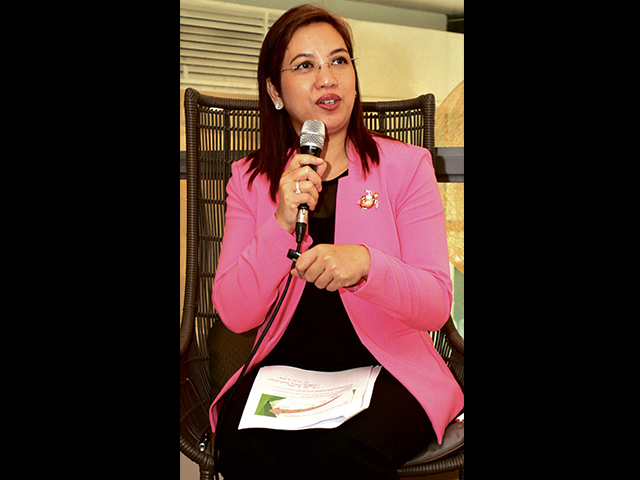
Vaccinating school-aged girls against the sexually transmitted human papillomavirus (HPV), the virus that causes cervical cancer, does not mean they’ll grow up to become promiscuous adults. Immunizing young girls against cancer may be the best gift parents can give to their children.
This is the message Health Secretary Janette L. Garin hopes to impart when the Department of Health (DOH) rolls out its immunization program in August this year. Garin was among the invited speakers in “Usapang Bakuna: Disproving Myths and Misconceptions About Vaccines,” a forum organized by the American pharmaceutical company Merck Sharp & Dohme (MSD).
DOH’s National Immunization program will include free HPV vaccination for some 300,000 Grade 4 students from the 20 poorest provinces in the country. “Why Grade 4? Because it is presumed to be the age when everyone still does not have any sexual contact,” Garin said.
The best time to administer immunization is when children have not yet been exposed to the virus, added Dr. Rosa Maria Nancho, MD, former president of the Society of Adolescent Medicine of the Philippines Inc.
“One-third of our young population is already sexually active—as early as 12, 13 years old. Even if you think your daughters are not sexually active, their partners could be, and they could transmit the virus to the girls. Besides, how often do we really get a chance to prevent cancer?” Nancho said.
No symptoms
An HPV infection transmitted during the early teens will not manifest any symptoms of the disease—in this case, cervical cancer—until the teen hits her 40s. By this time, she could already be a mother at the height of her professional career.
DOH will also launch its antitetanus and antidiphtheria booster programs to some 2.43 million Grade 1 public school students around the country, and will also roll out its booster shots against rubella and measles to over 1.5 million gradeschoolers in public schools.
Garin said the free HPV vaccination is optional. Children will need to get their parents’ consent first, hence it is critical that parents keep an open mind.
Lack of knowledge and lack of urgency are among the top reasons parents do not allow their daughters to receive HPV immunization. Some doctors and health practitioners also do not recommend it, said Nancho, and misconceptions about its side effects, such as fainting, have raised unnecessary fears among parents.
“There have been fainting spells among Australian children after immunization, but we soon learned it was because they were exposed under the sun immediately after. They fainted because it was too hot,” Nancho said.
Dr. Benjamin Co, MD, a fellow at the Philippine Pediatric Society, said another misconception about any type of immunization is that it causes autism. In a 1998 study, the British Medical Journal described an elaborate fraud linking autism to MMR (measles, mumps, and rubella vaccine).
He said the study, led by Dr. Andrew Wakefield, has been debunked by the World Health Organization as having no scientific basis to support claims that measles vaccination may be a risk factor for autism. Studies have also shown that immunization does not lead to permanent neurological problems.
“If a doctor tells you a medicine has no side effects, he or she is lying. There is nothing that is absolutely safe, whether you are looking at a medical drug or a product that has no therapeutic claim. That said, even vaccines have side effects,” Co said.
14 vaccines in their first year
Parents, however, must weigh the benefits and risks when deciding on vaccinating their children. If the benefits outweigh the risks, then by all means give your child the immunization he or she needs, Co said.
Children, for example, receive 14 vaccines in their first year of life and are exposed to 160 immunologic components in the vaccines, Co said. When they are exposed to a bacterium in the environment, the immune system has to stimulate almost 6,000 immunologic components in the system to prevent an infection. That means a child who has not been immunized will continually have to work in order to fight the infection, rather than passively receive it.
“That multiple vaccinations can overwhelm the immune system of a child is the greatest myth of all,” Co said.
Some adjuvants, such as aluminum, are included in the vaccine so that it stimulates the immune system to respond to the vaccine—but that does not mean they are toxic.
The preservative thiomersal, which contains mercury and is usually found in multivial preparations, is not toxic to the nervous system, as well. The kind found in vaccines is ethyl mercury, and this is water-soluble and rapidly metabolized in the body so they do not accumulate, he said. (Deep-sea fish like salmon and tuna, on the other hand, contain the toxic methyl mercury.)
“Some doctors will not tell patients about the side effects of vaccines, such as pain. But there is no such thing as an immunization that is pain-free. Over one million infants and young children die each year from vaccine-preventable infections. A large number of deaths could have been prevented if only children had been immunized,” Co said.
Garin said the Philippines has been polio-free since October 2000. Today, there is a need to sustain disease elimination of measles, chronic hepatitis B, diphtheria, pertussis, Hib meningitis, and severe diarrhea caused by rotavirus, rubella, or German measles.
DOH, she said, hopes to improve vaccination coverage via their Reaching Every Purok program. She encourages local government officials to adopt principles of good immunization practices. Garin said the budget for DOH’s National Immunization Program will come from sin tax revenues.